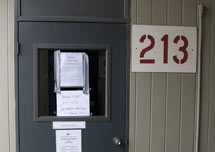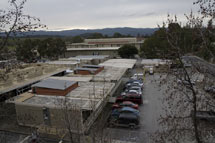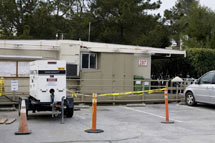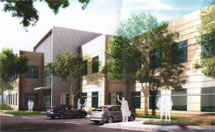
Handy Links
SLAC News Center
SLAC Today
- Subscribe
- Archives: Feb 2006-May 20, 2011
- Archives: May 23, 2011 and later
- Submit Feedback or Story Ideas
- About SLAC Today
SLAC News
Lab News
- Interactions
- Lightsources.org
- ILC NewsLine
- Int'l Science Grid This Week
- Fermilab Today
- Berkeley Lab News
- @brookhaven TODAY
- DOE Pulse
- CERN Courier
- DESY inForm
- US / LHC
SLAC Links
- Emergency
- Safety
- Policy Repository
- Site Entry Form

- Site Maps
- M & O Review
- Computing Status & Calendar
- SLAC Colloquium
- SLACspeak
- SLACspace
- SLAC Logo
- Café Menu
- Flea Market
- Web E-mail
- Marguerite Shuttle
- Discount Commuter Passes
-
Award Reporting Form
- SPIRES
- SciDoc
- Activity Groups
- Library
Stanford
Around the Bay
Storm Damage Likely to Accelerate Some Planned Office Moves
Thanks to an intense two-weeks' effort from emergency, security and facilities staff, SLAC has recovered quickly from late January storm damage. After lightning caused a site-wide power outage, PG&E and SLAC crews had most of the lab operational again within two days. Facilities staff have cleared the worst of the mudslides and flooding. SLAC is perhaps fortunate that buildings sustaining the worst damage were mostly well-worn temporary structures, already slated for replacement. The residual damage, though, will accelerate office moves that were scheduled to begin in summer 2010 and beyond.
More than 80 staff members from damaged buildings are already working in temporary locations across the site. To set them up with longer-term space, a core team from the Operations and Accelerator Directorates is assessing which damaged areas can be made usable until the planned replacement space is open, and where existing space can accommodate more people.
"It's a fairly complicated shell game that we have to play, to move things around," said Deputy Chief Operating Officer Mark Reichanadter. "We don't want to repair some buildings now only to demolish them in June. That doesn't make sense. And we don't want to move staff back in only to move them back out again so soon."
Water leakage from heavy rains damaged floors, ceilings and equipment in Buildings 3 and 299, which house Environment, Safety and Health Department radiation and environmental safety staff, and in the cluster of office structures known as PEP City or SLC City—Building 214 and nearby office trailers—where staff from the Particle Physics and Astrophysics Division, Accelerator Research Department, Security Department and Infomedia Solutions worked. Electrical, heating and air-conditioning, and structural repairs in Buildings 3 and 299 should be complete around mid-February, according to Director of Facilities Matt Wrona. The schedule includes time for air testing by industrial hygienists to make sure the air is clear of unhealthy mold and fungus. Repairs for PEP City, scheduled for demolition in fall, are less clear-cut.
"There was quite a bit of damage due to storm," Wrona said. Both electrical systems and building structures took major hits. "The old electrical system sustained damage, including the power feeds as well as some of the transformers."
Together with PEP City, this left Buildings 32, 266, 267 and 207 without power. Emergency diesel generators were brought into service to power those trailers, to enable essential functions in fire detection, security, badging and communications last week. As of Saturday morning, January 30, Buildings 32, 266 and 267 were restored to main power. Building 207 remains on a temporary generator. Since these structures were mostly undamaged, they are expected to remain in use. But PEP City is another matter.
"About fifty percent of the buildings in PEP City were damaged," Wrona said. Those buildings were slated for demolition this fall, so it would not be cost-effective to refurbish them, he noted. Power was restored to Buildings 259, 228, 287 and 229 late Friday afternoon, and these areas passed a thorough review by both the Facilities and ES&H Divisions to ensure building systems are clear of any health hazards. Notification was sent to building managers yesterday indicating that these buildings are available for occupancy. Meanwhile, power remains de-energized to Buildings 208, 210, 212, 213 and 214. Between structural and electrical systems damage, portions of PEP City are unlikely to return to service.
"If we can, the preference would be to relocate those staff now," Wrona said. "We were going to start relocating them in June. The only problem is that we have less space now than we will have in June."
Replacement accommodations will not become available until this summer and beyond. The new LCLS research office building and additional PULSE Institute labs and offices in Building 40 are expected to begin move-ins in June. Additional future space will open with renovation of Building 28 and upgrades in Building 40 to create dedicated space for the Stanford Institute for Materials and Energy Science, slated for completion in 2011 and 2012, respectively. In the interim, space will be tight.
"Where we can double up on space and minimize inconvenience, we will," Wrona said.
The team coordinating the office moves will bring in a senior-level space planner, starting in mid-February. The group will work closely with building managers for the affected areas to determine needs, available space and best solutions, noted Conventional Facilities Systems Manager David Saenz. "We will be keeping coworkers together wherever possible," he said, "and working to make sure everyone is in a workable situation."
—Shawne Workman
SLAC Today, February 2, 2010



